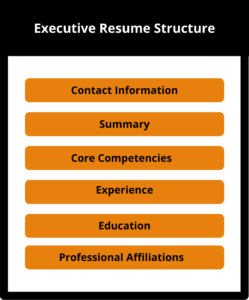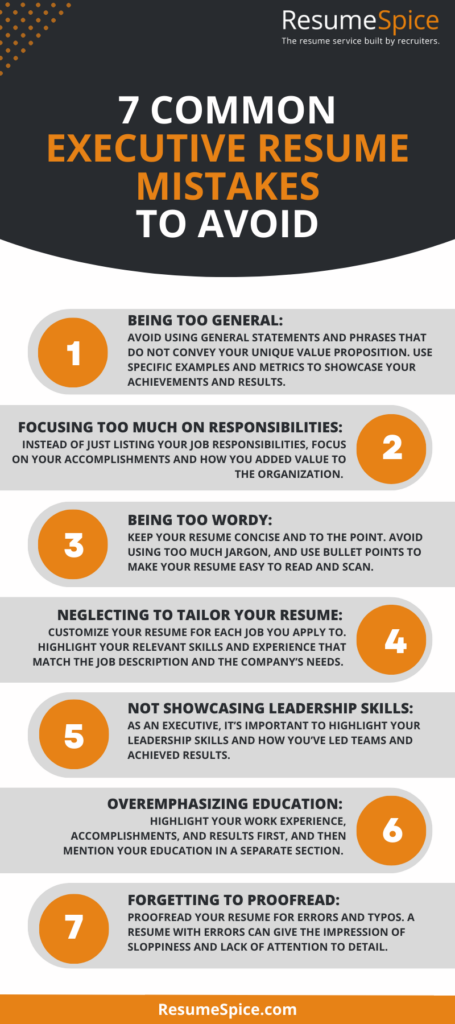
Your resume has always been the gateway to opportunity, but when you’re interviewing at the executive level, the stakes are higher than ever.
Showcasing your unique skills and accomplishments is one function of your executive resume, but the other is helping you stand out in a sea of applicants. You may be able to get away with a generic resume in the earlier stages of your career, but having a masterful executive resume is where the bar starts for Executives, Presidents, C-Level, VPs, and Directors.
In this post, we will provide you with valuable tips and insights on how to create an outstanding executive resume. We will cover key elements that should be included in your executive resume, as well as some additional tips to help you get ahead of the curve.
So, whether you are an experienced executive looking for a new challenge or a rising star in your industry, this post will help you create a powerful executive resume that will get you noticed by hiring managers and recruiters.
What is an Executive Resume?
An executive resume is a type of resume specifically tailored for professionals who are in high-level positions, typically in the C-suite or senior management roles. Executive resumes are designed to showcase a candidate's extensive experience, leadership abilities, strategic thinking skills, and are often used to apply for executive-level positions or board positions.
Your executive resume should highlight your achievements and results, rather than just your job duties or responsibilities. All other relevant information, such as certifications, education, and industry recognition should also be included in your resume.
What you’ve used at entry-level and middle management is not enough to advance your career to the next level. An exceptional executive resume is the key to the next stage of your career.
An executive resume’s primary function is to show how hiring you will advance and improve the company. The hiring team is trying to make a decision based on ROI, perceived benefits, and the vision that you can bring to your function. Your resume can’t just show what you’ve done in the past. It needs to make it a no-brainer for the hiring team to choose you.
Researching and Planning Your Executive Resume
When it comes to writing your executive resume, most of your effort should be focused on just that: writing! The format, layout, and colors (spoiler alert: none!) you use will matter, but the content of your resume should do the bulk of the work.
For this reason, it’s important to do the legwork to understand how you should be crafting your resume. Here is a simple process outlining the prep work you should do before you make the first draft of your resume:
1. Identify your target audience
Your resume should be tailored to be the answer to a specific problem. That means you should know everything about the target audience you’re trying to captivate. When researching, answer questions like:
- Who is on the hiring team?
- Who will be reading your resume?
- Will someone (or something, in the case of an Applicant Tracking System) be screening it before it gets to the ultimate hiring authority?
- What tone should be portrayed here?
- What values are important to them?
- What results are they looking for?
2. Research your industry and target companies
Next, you’ll want to make sure that you have a thorough understanding of your target industry. This means you don’t just need to understand the company to which you’re applying, but their competitors and partners as well.
When researching, answer questions like:
- What is the history of this industry?
- What are common problems companies like this are facing?
- What is the current marketplace like for them?
- What trends are predicted for the next 1, 3, and 5 years in this industry?
Analyze the job requirements, and identify the keywords and phrases that are commonly used. This will help you optimize your resume for Applicant Tracking Systems (ATS) and increase your chances of being selected for an interview.
3. Assess your skills and achievements
The most important part of your research is drawing parallels between your experience and skills and the problems the company is looking to solve.
When prepping to write your resume, be thorough about the results your skills and achievements produced in past positions. Ask questions like:
- What soft and hard skills does the ideal candidate for this position have?
- What have other people in similar positions done that have made them successful?
- What is my unique selling point I can leverage on this resume?
- How can I use metrics and quantifiable data to showcase the impact of my work on the company's bottom line?
Keep all your notes organized in a doc so it’s readily available when it comes time to write your resume.
Structuring an Executive Resume
Structuring an executive resume is simple, but the attention to detail you show will be impactful for your success.
Here is the basic resume format to follow for an executive:
- Contact information
- Title + Branding Statement
- Core Competencies
- Experience
- Education
- Professional Affiliations

As you’re laying out the structure for your resume, make sure you take note of opportunities to add keywords and descriptions that match the ones on the job listing.
1. Writing your Contact information
Keep it simple with your contact information by simply adding:
- Your name
- Location – City, State only (exact addresses are no longer necessary)
- If applying to a remote role, include that you’re open to remote work.
- IFor non-local roles, include that you’re open to relocating, if the job requires it.
- Phone number
- Email address
- LinkedIn profile
Additionally, you'll want to consider:
- Adding a link to your portfolio or website.
- Make sure hyperlinks are added to the doc, since it will likely be viewed digitally.
- 87% of recruiters check LinkedIn before interviewing candidates, so be sure your profile is up-to-date.
2. Writing your Title and Branding Statement
Writing your Title and Branding Statement should take a lot of research and prep since these couple sentences will not only give the hiring manager a taste of your skills, but your persona as well.
Keep these tips in mind:
- Your Title should match the job to which you’re applying, as closely as possible. Similarly, your Branding Statement should be the perfect blend of experience, positions, and the role to which you’re applying.
- Highlight your most relevant skills, experiences, and achievements to make a strong first impression on the hiring manager.
- Keep it brief and focused, ideally no more than 2-3 sentences.
- Use action verbs and quantify your achievements whenever possible.
- No need to title this section “Summary” or “Objective”, since your professional title will be more resolute.

3. Writing your Core Competencies
By highlighting your key competencies, you can quickly grab the attention of hiring managers and recruiters, and demonstrate your potential value to the organization.
This section is particularly important for executives who may have a wide range of experience and skills, as it allows you to focus on the specific areas where you excel and stand out from other candidates.
- List 10-15 of your skills best suited for your desired position, separating them with bullet points.
- Alternatively, you can list 4-6 of your most important skills, with a brief description of each one.
- Choose skills that are relevant to the job to which you’re applying, and avoid generic or overused terms.
- Use a bullet point format, and make sure your list is easy to scan and read quickly.
4. Writing about your Experience
Perhaps the part that is most overwhelming to candidates is the job experience section of an executive resume. Much attention to detail should be used here, so refer to your notes often as you craft your experience descriptions.
These tips are absolutely essential when you’re writing an executive resume:
- The best resume format is reverse chronological order, starting with your most recent position.
- Use bullet points to highlight your achievements, responsibilities, and specific accomplishments in each role.
- Focus on the results you achieved, rather than just describing your duties or responsibilities.
- Use specific numbers and data whenever possible, to demonstrate your impact and success in each role.
- Tailor your experience section to the job to which you’re applying,, highlighting the experiences and achievements that are most relevant to that position.
- Like the age-old writing advice, be sure to “show” not “tell” your experience and the results it will afford your potential employer..
5. Writing about your Education
- List your degrees in reverse chronological order, starting with your most recent degree or certification.
- Include the institution's name, your degree or certification, and your graduation date.
- If you graduated with honors or received any special awards or recognition, you can also include those.
- If you have relevant coursework or certifications that are not part of your degree, you can include those in a separate section.
6. Writing Professional Affiliations/Technical
- Use this section to highlight any relevant professional affiliations, certifications, or technical skills that you have.
- Include the name of the organization or certification, as well as the date you received it and any relevant details.
- Make sure that the affiliations and technical skills you list are relevant to the job to which you are applying, and are not outdated or irrelevant.
- If you have an extensive list of technical skills or certifications, you can create a separate section for them, and use a bullet point format to make them easy to read and scan.

When writing your executive resume, keep the structure simple and the content rich
A flashy and over-the-top resume is not going to make up for poor content, and could even detract from an otherwise strong resume.
In fact, design elements (such as color fonts, pictures, and unique layouts) should not be used unless you’re applying for a creative position.
Read: Should You Add Color to Your Resume?
Remember that a resume is marketing. Everything about your resume should be written with your potential employer in mind, not your own showcase.
Go through each part of your resume and make sure that it’s written in a way that sells the benefits of hiring you.
(This is where getting some expert eyes or an executive resume writer on your side can really help you. They can identify and recommend ways to enhance your resume that most executives may not be aware of.)
Additional executive resume writing tips:
- Focus on the employer's needs: Your resume should not just be about you, but about how you can meet the employer's needs. Understand the company and the position requirements, and adapt your resume accordingly.
- Highlight relevant skills, experience, and education: Focus on the key skills, experiences, and education that are relevant to the position you're applying for.
- Separate older positions: If you have positions that are not relevant to the job you're applying for or were held more than fifteen years ago, create a separate section with just the position titles and dates to manage the document length.
- Create different versions of your resume: To effectively target different positions and organizations, you may need to create several different versions of your resume. Each version should be tailored to the specific job and company you're applying to.
Designing an Executive Resume
When designing an executive resume, it's important to keep in mind that the design should complement the content, not overshadow it. Choose a professional and clean layout that is easy to read and navigate, and includes lots of white space.
Select a font that is easy to read and professional, and use a color scheme that is subtle and doesn't distract from the content. Some popular font choices for executive resumes include Times New Roman, Arial, and Calibri.
When it comes to adding visual elements, use them sparingly and strategically. While we don’t recommend images, logos, or charts in an executive resume, if your preference is to include them, be sure not to overdo it. They can quickly make the resume look cluttered and unprofessional.
Remember, the goal is to present a clear and concise overview of your skills and experience, so the design should enhance the content, not detract from it.
- Stick to a traditional and clean format, avoiding overly trendy designs. For example, we love Canva for graphic design, but we don’t recommend their resume templates unless you’re in a creative field.
- Ensure a balanced ratio of white space to text, making your resume easy to read and scan.
- Use one-inch margins on all sides to avoid cutting off important information when printed.
- Format body copy at 11 or 12 points and headlines at 14 to 18 points for clarity and legibility.
- Use a consistent font throughout to maintain a cohesive and professional look.
Executive Resume FAQs
Q: How long should an executive resume be?
A: An executive resume should typically be 2-3 pages long, depending on the candidate's level of experience and the position they are applying for.
Q: Should I include all of my work experience on my executive resume?
A: It is not necessary to include every job you've ever had on your executive resume. Instead, focus on highlighting your most relevant and impressive experiences that are directly related to the position to which you are applying.However, be careful not to create unnecessary employment gaps (addressed below).
Q: Should I include references on my executive resume?
A: It is not necessary to include references on your executive resume. Instead, have a separate list of professional references ready to provide upon request.
Q: Should I use a professional resume writer to help me create my executive resume?
A: A professional resume writer can help you craft a polished and effective executive resume that effectively showcases your skills and experiences.
Q: What should I do if I have employment gaps on my executive resume?
A: Address employment gaps on your executive resume by providing a brief explanation for the gap and highlighting any relevant activities or experiences you engaged in during that time.
Common Executive Resume Mistakes to Avoid
Here are some common resume mistakes to avoid while creating an executive resume:
- Being too general: Avoid using general statements and phrases that do not convey your unique value proposition. Use specific examples and metrics to showcase your achievements and results.
- Focusing too much on responsibilities: Instead of just listing your job responsibilities, focus on your accomplishments and how you added value to the organization.
- Being too wordy: Keep your resume concise and to the point. Avoid using too much jargon, and use bullet points to make your resume easy to read and scan.
- Neglecting to tailor your resume: Customize your resume for each job you apply to. Highlight your relevant skills and experience that match the job description and the company’s needs.
- Not showcasing your leadership skills: As an executive, it’s important to highlight your leadership skills and how you’ve led teams and achieved results. Showcasing your leadership skills is crucial in convincing employers that you can lead their team.
- Overemphasizing education: While education is important, it should not be the main focus of your executive resume. Highlight your work experience, accomplishments, and results first, and then mention your education in a separate section.
- Forgetting to proofread: Always proofread your resume for errors and typos. A resume with errors can give the impression of sloppiness and lack of attention to detail.

Writing an executive resume requires careful planning, research, and attention to detail. By following these tips and guidelines, you can create a powerful and effective resume that showcases your skills, achievements, and experience in a clear and concise manner.
Remember to keep the structure simple and the content rich, highlight your accomplishments, and focus on the needs of the employer. With the right design and layout, your executive resume will stand out and make a lasting impression on potential employers.
Keep in mind that crafting a great executive resume is a process that takes time and effort, but the end result will be well worth it in your pursuit of a successful career.
Land your next position with ResumeSpice
Having a powerful resume is crucial for landing your next job. Instead of guessing your way through, use the expertise of our professional resume writers for writing and formatting your resume. To get started with the ResumeSpice team, you can call us at 832.930.7378 or connect with us online.









